In this article, you will learn the different parts of dc generator and their functions. All are explained with Names & Pictures.
You can also download the PDF file of this article at the end.
What is DC Generator?
When the local grid is down, independent machines called electrical generators can supply electricity. During power shortages, these generators provide supplemental power to homes and businesses.
A device that transforms mechanical energy into electrical energy in the form of direct current is a DC generator, also referred to as a dynamo. It operates according to the electromagnetic induction law of Faraday, which states that when a conductor moves through a magnetic field, a voltage is induced across the conductor.
A magnetic field system, an armature, and a commutator are the fundamental parts of DC generator. A magnetic field consists of stationary magnets, and an armature consists of a rotating coil of wire connected to the external circuit.
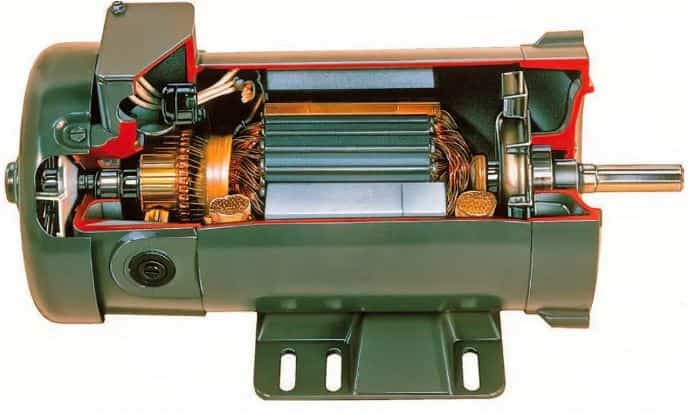
Magnetic lines of force cross the wire as the armature rotates in the magnetic field, creating a voltage in the coil. However, since the voltage generated by the coil is alternating, it must be changed into direct current in order to be used in real applications.
To convert AC voltage to DC voltage, a commutator is used, which is a device that consists of contacts that break and make connections between the rotating coil and the external circuit at the appropriate time. A DC generator can be used in many applications, including powering electric motors, portable devices, and hybrid electric vehicles.
Read Also: 14 Essential Parts of Transformer & Its Functions [Complete Guide]
Parts of DC Generator
The construction of a DC generator can frequently be used as a DC generator motor. So a DC machine may typically be used to refer to a DC generator motor. The main parts of DC generators are the yoke, poles, pole shoes, armature core, armature winding, commutator, brushes, magnetic field system, commutator, end housings, bearings, and shafts.
These parts of DC generators will be covered in more detail below.
The primary parts of a DC generator are listed below, along with what they do:
- Stator
- Rotor or armature core
- Armature winding
- End housing
- Yoke
- Pole core
- Pole shoe
- Bearings
- Commutator
- Brushes
- Shaft
- Terminal box
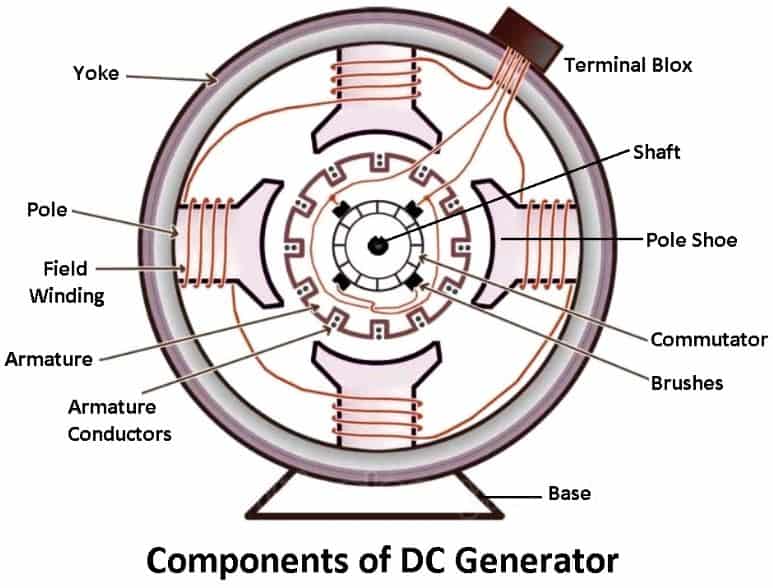
Read Also: Whare Are The Different Types of Gears & Their Applications?
#1 Stator
There are two main parts to a direct-current (DC) generator: a rotating section and a fixed section. The stator consists of several magnets or electromagnets that produce a magnetic field around the armature.
In a DC generator, the stator’s main work is to generate a powerful magnetic field that interacts with the armature to cause a voltage and produce electrical energy. It has two stable magnets with poles that are opposite to one another. In the rotor field, these magnets are mounted.
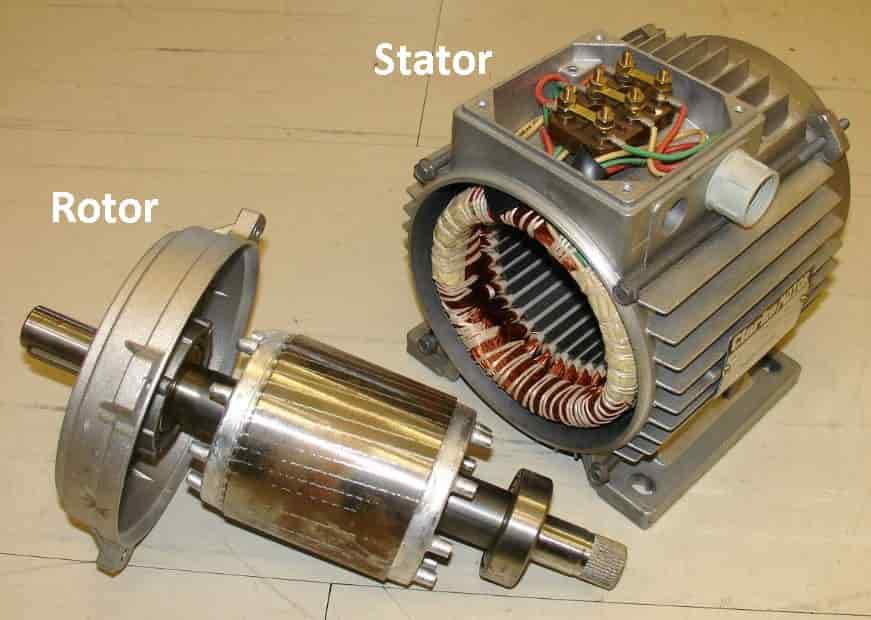
#2 Rotor or Armature Core
The rotor or armature core consists of a fan, an armature, a commutator, and a shaft. It is the second crucial part of a DC generator. The rotor’s main job is to spin within the stator’s magnetic field and produce electricity by causing a voltage in the armature winding.
It is usually a cylindrical or rectangular core made of soft iron or steel mounted on a shaft. As the rotor rotates, the armature winding cuts across the magnetic field lines generated by the stator, inducing an electromotive force (EMF).
As the rotor of a DC machine is made up of slotted iron laminations with slots that are stacked cylindrically, the core of the rotor is cylindrical. Lamination serves the purpose of reducing eddy current-related loss. The fan is liable for providing the required air for the rotating armature or rotor throughout the process.
Read Also: Different Types of Essential Electrician Tools [Names & Uses] Explained
#3 Armature Winding
The slots of the armature core are filled with insulated conductors. The conductors are properly connected and wrapped in steel wire groups that are wound around the core. This arrangement of conductors is known as armature windings.
The core of a DC machine is its armature winding. The process of converting power happens at the armature winding. Here, mechanical power is transformed into electrical power in the case of a DC generator.
The windings are divided into two categories based on connections: lap windings and wave windings.
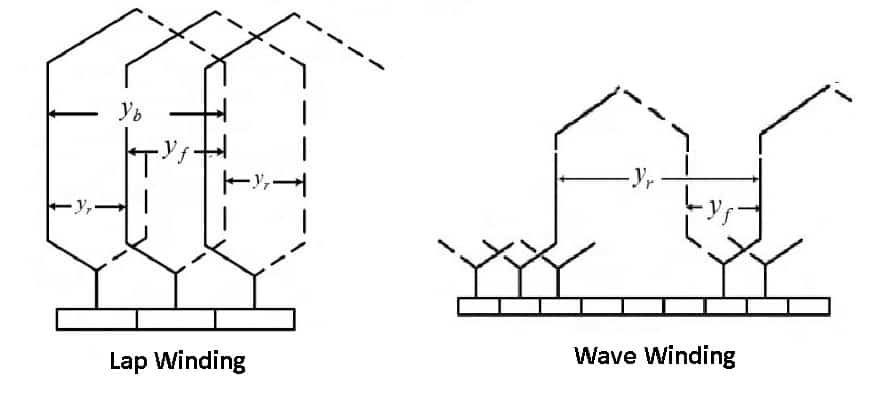
a) Lap Windings
In lap winding, the conductors are linked together so that the number of parallel paths and the number of poles are the same. As a result, if a machine has P poles and Z armature conductors, there will be P parallel paths and Z/P conductors connected in series on each path.
The quantity of brushes in lap winding is equivalent to the quantity of parallel paths. Out of which, 50% of the brushes are positive, and 50% are negative.
b) Wave Windings
In wave winding, the conductors are connected in such a way that no matter how many poles the machine has, they are split into two parallel paths. As a result, if the machine has Z armature conductors, there will only be two parallel paths, each with Z/2 conductors connected in series.
In this instance, the number of parallel paths, or brushes, is equal to two.
Read Also: What Are The Different Types of DC Motors? Its Application [Explained]
#4 End Housing
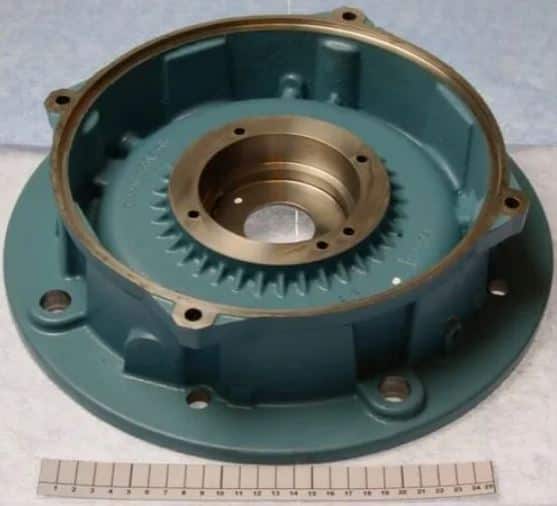
End housings are the parts placed on the mainframe’s ending sections and serve as bearing protection. The bearings help to reduce the friction between its moving and stationary parts, which can slowly degrade them over time. The end housings only serve to support the bearings; the front housings protect both the bearing and the brush collection.
#5 Yoke
DC generators are comprised of two parts: Yoke and foundation. Yoke provides mechanical protection to the inner assembly and ensures that the windings are fixed to the foundation, as well as creating a path for magnetic flow.
For larger machines, it is made of cast steel or rolled steel, and for smaller machines, the yoke is typically made of cast iron. Following are the yoke’s two main functions:
- It supports the pole cores and shields the machine’s interior components mechanically.
- For the magnetic flux, it offers a low-reluctance path.
Read Also: Different Types of Circuit Breakers: Working & Applications
#6 Pole Core
The main purpose of poles is to maintain the sector’s windings. These windings are usually wound on the poles and joined to the armature windings in a particular sequence. As a result, the poles attach the welding technique to the yoke using screws.
A pole core consists of thin, annealed steel or wrought iron rods connected by hydraulic pressure. In a DC machine, the poles are laminated to minimize Eddy’s Current loss.
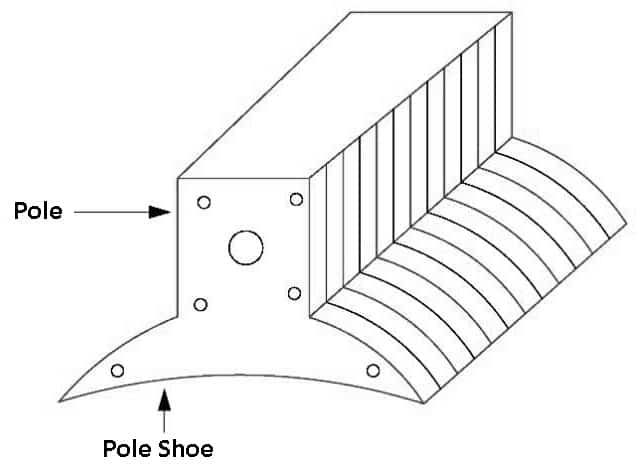
The following functions of the poles core are listed:
- It generally supports the field or exciting coils.
- They uniformly distributed the magnetic flux over the armature’s periphery.
- It expands the magnetic circuit’s cross-sectional area, which lowers the magnetic path’s reluctance.
#7 Pole Shoe
The pole shoe is a structural component made of iron or steel that is used primarily to disperse the magnetic field flow and to prevent the spinning field coil from falling out of the pole.
Read Also: Different Types of Insulators Used In Power Transmission Lines [Must See]
#8 Bearings
In a system, bearings are used to ensure smooth movement among the various parts. Bearings’ primary purpose is to reduce friction between the machine’s rotating and stationary components. Due to its hardness, high-carbon steel is the most commonly used material for bearings.
These are made to be continuously greased and shielded from dust infiltration. Roller bearings and ball bearings are the two most common types of bearings. Ball bearings are made up of spherical balls that transfer load from the inside to the outside and create circular motion.
Roller bearings, as opposed to ball bearings, are composed of various types of cylinders. Unlike ball bearings, roller bearings have a line of contact with the load, allowing them to handle heavy loads; therefore, roller bearings are mainly used in industrial machinery.
#9 Commutator
Commutators rotate with armatures and are made of hard-drawn copper bars or segments insulated from each other and the shaft. They are usually cylindrical in shape. Around the armature’s shaft, the segments come together to form a ring. The ends of the armature coils are connected to each segment of the commutator.
The commutator is the most crucial part of a DC machine and has the following functions.
- Through brushes, it joins the stationary external circuit and rotating armature conductors.
- When used in a DC generator, it converts induced alternating current in the conductor of the armature into a unidirectional current. In contrast, in the case of a motor, it transforms the alternating torque into a unidirectional (continuous) torque produced in the armature.
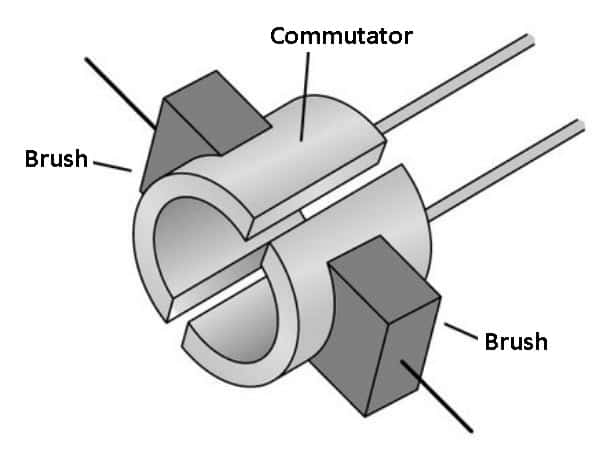
Read Also: What Are The Different Types of Transformers? Explained with Applications
#10 Brushes
Current is drawn from the armature winding using two or more carbon brushes mounted or placed on the commutator. A brush box supports each brush. The brushes are pressed against the commutator and serve as a connecting element between the armature winding and the external circuit.
Springs are used to adjust and maintain the constant pressure that the brushes apply to the commutator. The brushes enable the current generated on the windings to be transferred to the commutator and then to the external circuit.
They are typically made of high-grade carbon because it is a conductor and when in powder form, have a lubricating effect on the surface of the commutator.
#11 Shaft
In a DC machine, the shaft is a mechanical component that causes rotation by producing the torque, which is a rotational force. It has maximum breaking strength and is made of mild steel.
Among the generator components, the shaft is responsible for helping the generator transfer mechanical energy. A rotating component keyed into the shaft includes the armature center, the commutator, the cooling fan, etc.
#12 Terminal Box
The electrical connections for the generator are kept in a metal container called the terminal box. It offers a safe and secure location to connect the generator’s external circuit.
Wrapping It Up
The stationary stator and the rotating rotor are the two main parts of a DC generator. A magnetic field is produced by the stator, which also has brushes that change AC voltage to DC.
The commutator, brushes, and armature winding that transform AC voltage to DC are all located inside the rotor. For the generator to produce electrical power effectively, both components are necessary.
That’s it. Thanks for reading. I hope I have covered everything about “Parts of DC Generator.” It would be helpful if you could let me know if there was anything I missed or if you have any doubts about anything I wrote. Please share this article with your friends if you find it interesting.
Want free PDFs direct to your inbox? Then subscribe to our newsletter.
Download PDF of this article:
You might like to read more in our blog:
- What Are The Types of AC Motors and Their Functions?
- Different Types of Inductors and Their Applications [Full Guide]
- Types of Capacitors: Definition, Diagram, Working, Uses [Complete Guide]
- Understand Different Types Of Resistor Explained With Symbols
- What is Servo Motor? Diagram, Definition, Types, Working & Uses
Major appreciation for this post on parts of dc generator. Thank you ever so much for making this available!
You’re welcome.
PLEASE I NEED THIS NOTE
The PDF file has been sent to your inbox.
Beautifully Explained. Thanks
You’re welcome.
Please I need this in PDF
The PDF file has been sent to your inbox.